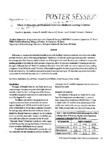Please use this identifier to cite or link to this item:
http://www.alice.cnptia.embrapa.br/alice/handle/doc/15665| Title: | Effects of attenuation and dispersion factors on Tebuthiuron leaching simulation. |
| Authors: | SPADOTTO, C. A.  MATALLO, M. B.   GOMES, M. A. F.   LUCHINI, L. C.   CERDEIRA, A. L.   |
| Affiliation: | CLAUDIO APARECIDO SPADOTTO, SGTE; Marcus Barifouse Matallo, Instituto Biológico; MARCO ANTONIO FERREIRA GOMES, CNPMA; Luiz Carlos Luchini, Instituto Biológico; ANTONIO LUIZ CERDEIRA, CNPMA. |
| Date Issued: | 2007 |
| Citation: | In: ANNUAL MISSISSIPPI WATER RESOURCES CONFERENCE, 37., 2007, Jackson. Publications... Jackson: Mississippi State University, 2007. p.25-28. |
| Description: | Differences on response of mathematical models on herbicide leaching in the environment can occur due to the models and their limitations, mainly when using soil lysimeters. Tebuthiuron is a herbicide used in sugarcane crop and is applied in the recharge area of the Guarany aquifer in Brazil, one of the largest in the world. This study was conducted to compare the leaching potential of the herbicide within lysimeters using sandy soils of the Espraiado watershed in the recharge area from the region of Ribeirão Preto, SP, Brazil. The traditional Attenuation Factor (AF) model was used at various soil layers, adding a Dispersion Factor (DF) to the model. The fitness of the model was good for the total amount of tebuthiuron leached, but not for the rate of leaching. The model overestimated the level of herbicide leaching at 100 days after application, but the final concentration leached with the water was as predicted by the model. |
| Thesagro: | Águas Subterrâneas Herbicida Modelo Matemático |
| Type of Material: | Artigo em anais e proceedings |
| Access: | openAccess |
| Appears in Collections: | Artigo em anais de congresso (CNPMA)  |
Files in This Item:
| File | Description | Size | Format | |
|---|---|---|---|---|
| 2007AA056.pdf | 232.6 kB | Adobe PDF |  View/Open |









